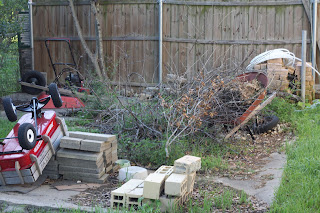The Party of the Shires has been a wonderful outlet for ideas on how to transition to a more locally-based economy, and from this group I have learned about hugelkultur, aquaponics, lasagna gardening and keyhole gardening.
The idea with a keyhole garden is to build a garden that centers on a compost heap. The only water that is put into the garden goes onto the compost heap, and the plants, which are planted around this, send their roots toward the water and nutrients in the center.
Keyhole gardens have proven to be drought-beating sources of nutritious vegetables in Lesotho and Texas. I had been planning to build a hugelkultur garden on a concrete pad in my backyard that at one time served as a dog run for a previous owner. This pad had become a junk collecting spot, and I would like to turn it into a useful space. Inspired by the notion of using found materials described in keyhole gardening, I (with the help of my son) started the process of building a keyhole garden in this space last night. The following photos represent about three hours of work. While I did not follow Dr. Deb's plan exactly (my garden is about 9' in diameter and currently has broken bricks, concrete, steel wire, dirt, green vegetation and dead wood--not in any particular layering--and I'm using the plasic compost bin I already had), it does tie together some of the benefits of hugelkultur and keyhole gardening. I'm hopeful that the organic material in this raised-bed garden will provide a great source of moisture through our hot Texas summer! And there's the added benefit that my backyard is now a lot cleaner. I still need to add some more height to the wall and add layers of cardboard and soil. Once I get ready to plant, I'll be referencing Mel Bartholomew's Square Foot Gardening.





1 comment:
I'm curious how your keyhole garden is doing. I would also like to incorporate my compost bin into a khg, how did you address the issue of allowing nutrients leaching into the soil from the plastic bin?
Post a Comment